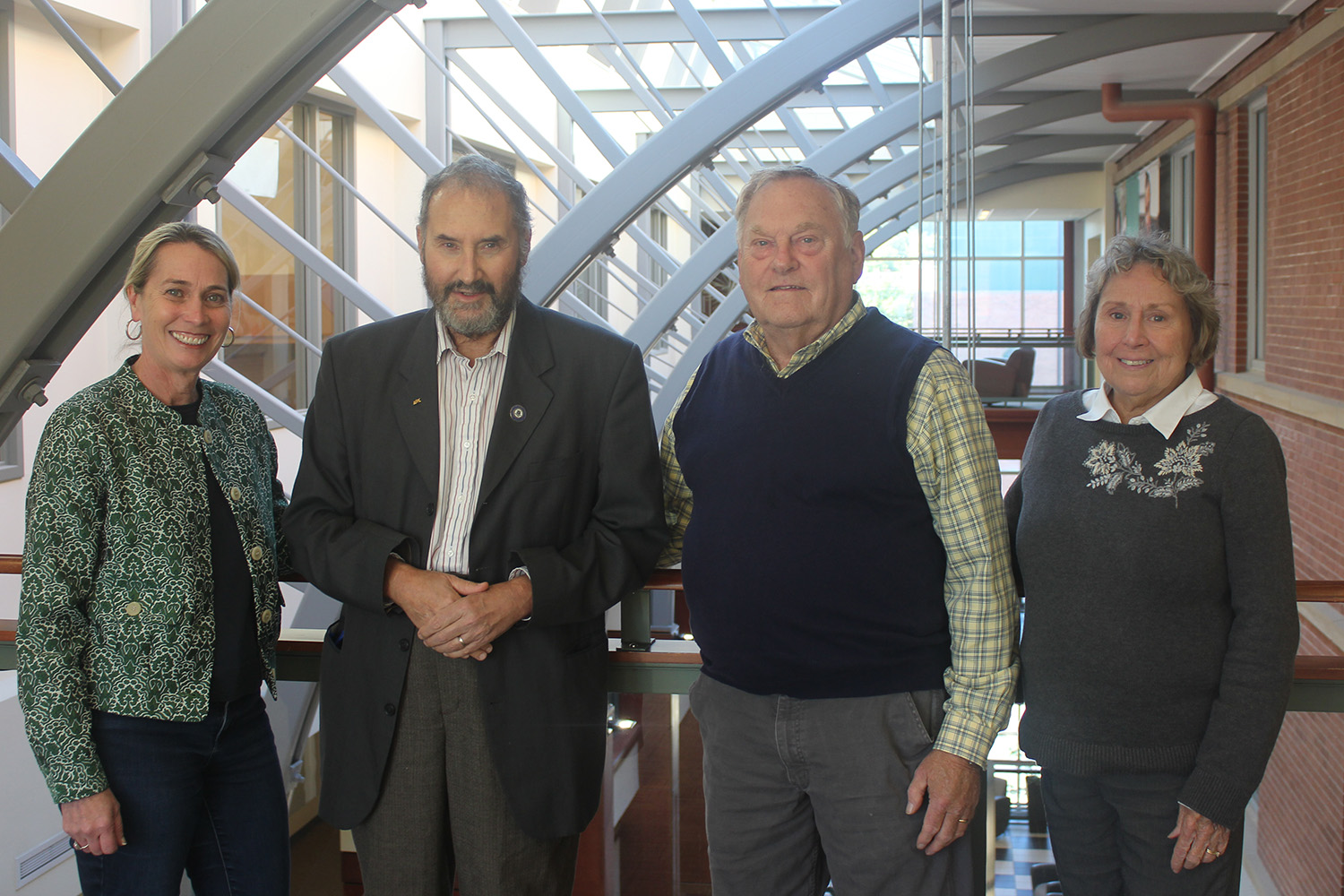There’s no mistaking Phragmites australis when you see it.
Growing upwards of 15 feet tall, it thrives in full sun, swaying in the breeze all spring and summer long. Though it’s called a common reed, it’s actually a perennial grass, non-native in the United States – and not actually from Australia, either.
Though there are native phragmites species, the most dominant type of phragmites is terribly invasive in Connecticut, putting down deep, thick root networks that spread through rhizomes, crowding out native species, and reducing plant diversity wherever it takes hold.
It grows in dense stands all around the state – on the edges of inland freshwater ponds, along marshy highway roadsides, and in brackish waters along the coast. Those stands are incredibly difficult to remove once they’ve taken hold.
“Phragmites is a very recognizable plant,” says Sydney Kolz ’26 (CLAS), an undergraduate researcher studying environmental science and ecology and evolutionary biology at UConn. “A lot of people who aren’t scientists or who aren’t working in conservation know what it is, because you see it everywhere.”
There’s been almost no stopping the spread of invasive phragmites over the last 100 years.
The tendrils of the phragmites’ purple-tinted seedheads emerge in late July and early August, turning into wispy dried florets by the autumn, scattering seeds widely by wind. Fragments of phragmites rhizomes are spread by humans, animals, water, and boats – boats are likely how the nonnative variety of the plant arrived here, hitching a ride on trans-Atlantic boat ballasts in the late 18th and early 19th century.
And despite how long nonnative phragmites has been a part of the environmental landscape in Connecticut, the Northeast, and beyond – today, invasive phragmites can be found in all 48 continental states – it hasn’t really assimilated with other native species.
“Invasive phragmites is eaten by herbivores a lot less than native phragmites and other native plants, which is a general trend with invasive plants,” explains Kolz, who is studying the invasive grass for her honors thesis, supported by an IDEA grant from UConn’s Office of Undergraduate research. “Part of the problem is that nothing’s eating it. Spiders will build nests or webs in phragmites. Some birds will make their nests in phragmites stands, so there are other ecosystem services it is providing. There’s a crab that eats its rhizomes.
“But as far as direct consumption goes, I’m pretty sure it’s only insects that are eating it purposefully in Connecticut.”
And those insects that do choose to feast on invasive phragmites, according to Kolz, are limited to only a few types – those that eat the leaves of the plant; stem borers and gall formers, which go into the stem of the plant and eat it from the inside out; and aphids, which suck the interstitial fluid from the plant’s leaves.
A member of the Elphick Lab at UConn, which does a lot of work in the area of conservation biology, Kolz became interested in studying phragmites, in particular, for a number of reasons.
“Phragmites is this very fast-moving and pervasive plant that is spreading across North America,” she explains. “I think that it’s ecological importance in that way warrants attention. It’s recognizable, which is important for getting the public involved in public policy. But it’s also relevant to the lab that I work in, because Dr. Chris Elphick’s lab has a lot of focus on salt marshes.”
Unlike the plants she’s studying, Kolz is a Connecticut native – she grew up in Oakdale, a village within the town of Montville, located in the southeastern part of the state. Her parents raised her to be “very outdoorsy,” she says, and she still harbors a close personal connection with nature. She’s serving as the vice president of UConn’s popular Outing Club this year.
In high school, an environmental science class taught Kolz about how integrative and multidisciplinary environmental problems are – she wanted to learn, and to do, more. At UConn, she’s studying in the biodiversity and conservation biology fast-track program. She hopes to complete her undergraduate studies this coming spring, and a Master of Science the following year.
Her study of Phragmites australis is focused on those bugs that eat the plants, and in particular how the salinity of the soil where the invasive phragmites take hold impacts the way that insects consume it.
While invasive phragmites will grow in brackish waters and salt marshes, salinity is a known stressor for the plant – you won’t find stands growing directly on the shoreline of Long Island Sound, for example, because the environment is too salty.
“We know that some herbivores express preferences for plants, whether they’re grown in saline or freshwater,” Kolz says. “With one plant species and one herbivore, that herbivore might prefer the plant that’s grown in saltier water or less salty water, but that’s not a general pattern. Each herbivore is different, and each plant is different. So, you really have to evaluate that on a case-by-case basis.”
When a plant has multiple things stressing it out – like when it takes root in a salty environment while bugs are chomping on it – those stressors can compound and make the plant more vulnerable. Understanding how those stressors interact can help understand how to control something that’s growing where you really don’t want it to.
In the case of invasive phragmites, no one has really looked at how these multiple stressors – salinity and herbivory – interacting at the same time could impact the plant, according to Kolz. So, that’s what she set out to do.
“I wanted to see how the effects of the herbivores of phragmites would be realized on this plant as it’s exposed to different amounts of salt stress,” she explains.
This past summer, she spent time traveling along the Connecticut coastline, visiting stands of invasive phragmites in salt marshes from Rocky Neck State Park in Niantic to Hammonasset in Madison, from Barn Island in Stonington to East River Marsh in Guilford, where she took soil samples along the salinity gradient in each location to analyze and document the plants’ salt exposure.
For each sampling location, she also observed, sampled, and documented what, if anything, was eating the plants at each of those areas along the salinity gradient.
She’s currently working on analyzing all of her data to see what, if any, conclusions can be drawn about how different levels of salinity impact the way those herbivorous insects choose to feast on nonnative phragmites. She hopes to ultimately prepare a scientific paper on her findings, in addition to presenting at Frontiers this spring.
Regardless of what she ultimately finds, Kolz says that the experience of conducting the research has helped her develop needed skills as a scientist, but also as a scientific writer, a grant writer, a communicator, and a problem solver – vital skills wherever her career might lead her in the future.
Ultimately, contributing to conservation action will always be important to her, she says, and conservation based on research is essential.
“I think, ideally, all conservation action is based on research that has shown, hey, this action has this effect, whatever that may be,” Kolz says. “If it’s on invasive plants, or protecting habitat for some endangered species, or restoring ecological function, ideally all conservation is based on science.”
The IDEA Grant program awards funding to support student-designed and student-led projects, including creative endeavors, community service initiatives, entrepreneurial ventures, research projects, and other original and innovative projects. For more information, visit ugradresearch.uconn.edu/idea.



